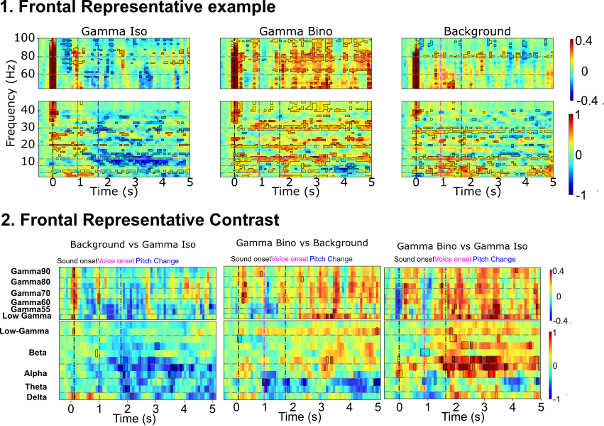Neonatal Neurology 2
Session: Neonatal Neurology 2
350 - Maternal singing synchronizes the preterm infants’ brain: Effects of Binaural Presentation and Gamma Stimuli
Friday, April 25, 2025
5:30pm - 7:45pm HST
Publication Number: 350.5858
MANUELA FILIPPA, University of Geneva, GENEVE, Geneve, Switzerland; Damien Benis, University of Geneva, Geneva, Geneve, Switzerland; Juliette Margaria, UNIGE, Geneva, Geneve, Switzerland; Francisca Barcos, HUG, Geneva, Geneve, Switzerland; Jenifer Miehlbradt, Universite de Genève, Geneve, Geneve, Switzerland; Laura Lavezzo, Universiy of Pisa, Pisa, Toscana, Italy; Didier Grandjean, University of Geneva, Geneva, Geneve, Switzerland; Stéphane Henriot, Binaural Care SASU, Thonon les bains, Rhone-Alpes, France; Petra S. Huppi, University Childrens Hospital, Geneva, Geneve, Switzerland
- MF
MANUELA FILIPPA, Dr (she/her/hers)
Maître Assistant
University of Geneva
GENEVE, Geneve, Switzerland
Presenting Author(s)
Background: It is well established that preterm infants' perception of their mother's speech is affected by the atypical hospital environment during a period of dramatic brain development. Singing to infants is a universal practice in human parenting, characterized by shared features across cultures, but the impact of prematurity on the preterm infant’s perception of maternal singing and music perception remains under investigated.
Objective: The main aim of the present study is to investigate the impact of prematurity on the preterm infant’s perception of maternal singing and music.
Design/Methods: In the present study, 12 preterm infants underwent high-density EEG testing at 37.27 ± 0.83 weeks of gestational age (mean ± SD). Following a 6-minute resting-state recording, the newborns were exposed to six blocks of auditory stimuli presented in a pseudo-random order. Each block contained 54 stimuli lasting 5 seconds each. The stimuli included the same melody sung by the infant’s mother, a stranger’s mother, played by an instrument, or to a background music, along with additional gamma beats. The sound stimuli were delivered via headphones with constant volume at 54 dbA under both monaural and binaural presentation settings. Data were analyzed using predefined scalp regions of interest (ROIs: frontal, central, right temporal, left temporal, and occipital). For each condition and ROI, time-frequency maps were averaged across trials and channels within the ROI.
Results: Our findings reveal that the mother’s singing voice in monaural presentation enhances unique brain synchrony across the entire scalp (Figure 1). Notably, binaural presentation decreases synchrony, particularly in the frontal region (Figure 2), while additional gamma beats elicit gamma responses in the whole scalp of the preterm neonatal brain (Figure 4).
Conclusion(s): Maternal singing remains a salient stimulus for preterm newborns in the atypical auditory environment of the neonatal intensive care unit, demonstrating a distinctive signature in brain responses. Furthermore, the presence of additional gamma stimuli, typically present in term born infants, shows promise in reestablishing equilibrium among brain frequencies, which is impaired by immature thalamocortical connections in the preterm brain.
Brain synchrony, which involves the simultaneous activity of neurons across different regions of the brain, is an essential component of optimal brain function. Its improvement, particularly in vulnerable populations such as preterm infants, could have a significant impact on their development.
Figure 1
.png) Mother’s voice elicits higher synchrony in preterm brain’s than stranger voice, Background and Instrument in the monaural setting in the frontal cluster. Average baseline corrected power (dB) per frequency bands, here separated by horizontal lines, relative to -0.05 -0.5 baseline. The contoured areas on the surface highlight regions 1. where at least one experimental condition shows a statistically significant change from the baseline (p < 0.05), 2. A main effect of auditory condition was found and 3. pairwise contrasts of interest reached statistical significance after correcting for multiple comparisons. Vertical lines: Black: Sound onset. Magenta: Voice onset. Blue: Voice pitch change.
Mother’s voice elicits higher synchrony in preterm brain’s than stranger voice, Background and Instrument in the monaural setting in the frontal cluster. Average baseline corrected power (dB) per frequency bands, here separated by horizontal lines, relative to -0.05 -0.5 baseline. The contoured areas on the surface highlight regions 1. where at least one experimental condition shows a statistically significant change from the baseline (p < 0.05), 2. A main effect of auditory condition was found and 3. pairwise contrasts of interest reached statistical significance after correcting for multiple comparisons. Vertical lines: Black: Sound onset. Magenta: Voice onset. Blue: Voice pitch change.Figure 2
 Binaural versus Monaural contrast for the Mother voice and Instrument, and Mother versus Instrument contrast in Binaural setting. Binaural stimuli generally decrease synchrony in preterm brain’s compared to monaural ones in the frontal cluster.
Binaural versus Monaural contrast for the Mother voice and Instrument, and Mother versus Instrument contrast in Binaural setting. Binaural stimuli generally decrease synchrony in preterm brain’s compared to monaural ones in the frontal cluster.
